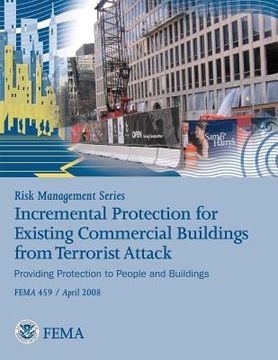Risk Management Series: Incremental Protection for Existing Commercial Buildings from Terrorist Attack (FEMA 459 / April 2008) (in English)
Synopsis "Risk Management Series: Incremental Protection for Existing Commercial Buildings from Terrorist Attack (FEMA 459 / April 2008) (in English)"
The Federal Emergency Management Agency (FEMA) developed FEMA 459, Incremental Protection for Existing Commercial Buildings from Terrorist Attack, to provide guidance to owners of existing commercial buildings and their architects and engineers on security and operational enhancements to address vulnerabilities to explosive blasts and chemical, biological, and radiological hazards. It also addresses how to integrate these enhancements into the ongoing building maintenance and capital improvement programs. These enhancements are intended to mitigate or eliminate long-term risk to people and property. FEMA's Risk Management Series publications addressing security risks are based on two core documents: FEMA 426, Reference Manual to Mitigate Potential Terrorist Attacks Against buildings, and FEMA 452, Risk Assessment: A How-To Guide to Mitigate Potential Terrorist Attacks Against Buildings. FEMA 426 provides guidance to the building science community of architects and engineers on reducing physical damage caused by terrorist assaults to buildings, related infrastructure, and people. FEMA 452 outlines methods for identifying the critical assets and functions within buildings, determining the potential threats to those assets, and assessing the building's vulnerabilities to those threats. This assessment of risks facilitates hazard mitigation decision-making. Specifically, the document addresses methods for reducing physical damage to structural and nonstructural components of buildings and related infrastructure and reducing resultant casualties during conventional bomb attacks, as well as attacks involving chemical, biological, and radiological agents. FEMA 459 can be used in conjunction with FEMA 452. This manual presents an integrated, incremental rehabilitation approach to implementing the outcomes of a risk assessment completed in accordance with FEMA 452, Risk Assessment: A How-To Guide to Mitigate Potential Terrorist Attacks Against Building. This approach is intended to minimize disruption to building operations and control costs for existing commercial buildings. The integrated incremental approach to risk reduction in buildings was initially developed in relation to seismic risk and was first articulated in FEMA's Risk Management Series in the widely disseminated FEMA 395, Incremental Seismic Rehabilitation of School Buildings (K-12), published in June 2003. In 2004 and 2005, FEMA also published Incremental Seismic Rehabilitation manuals (FEMA 396-400) for hospitals, office buildings, multifamily apartments, retail buildings, and hotels and motels. This manual outlines an approach to incremental security enhancement in four types of existing commercial buildings: office buildings, retail buildings, multifamily apartment buildings, and hotel and motel buildings. It addresses both physical and operational enhancements that reduce building vulnerabilities to blasts and chemical, biological, and radiological attacks, within the constraints of the existing site conditions and building configurations.

